The Induction Hob Market is estimated to be valued at USD 23.5 million in 2025 and is projected to reach USD 58.2 million by 2035, registering a compound annual growth rate (CAGR) of 9.5% over the forecast period.

| Metric | Value |
|---|---|
| Induction Hob Market Estimated Value in (2025 E) | USD 23.5 million |
| Induction Hob Market Forecast Value in (2035 F) | USD 58.2 million |
| Forecast CAGR (2025 to 2035) | 9.5% |
The induction hob market is expanding steadily as consumers shift toward energy-efficient and technologically advanced cooking solutions. Demand growth is being driven by rising urbanization, increasing disposable incomes, and heightened awareness of sustainable and safe cooking practices. Built-in smart features, precise temperature control, and reduced cooking times are enhancing consumer adoption.
Regulatory support for energy-efficient appliances and growing replacement demand in developed regions are also contributing to market expansion. Emerging economies are witnessing rapid penetration as modern kitchen designs and compact living spaces favor induction-based solutions.
The market outlook remains positive with manufacturers focusing on innovation, integration of IoT-enabled controls, and premiumization to cater to evolving consumer preferences Long-term growth rationale lies in the ability of induction hobs to align with global sustainability targets, lower operational costs, and enhance user convenience, ensuring continued adoption across both residential and commercial kitchens.
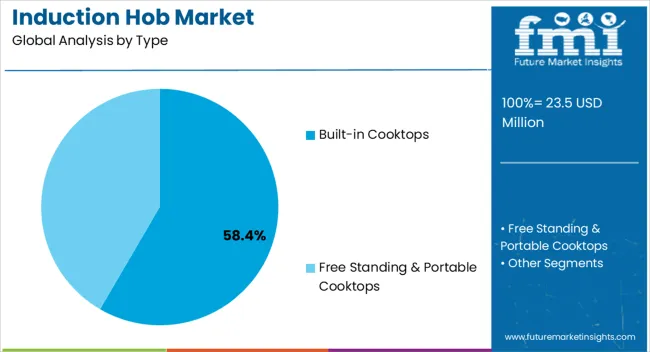
The built-in cooktops segment, holding 58.4% of the type category, has emerged as the dominant choice due to its seamless integration into modular kitchens and premium positioning in the appliance market. Consumer demand is being driven by aesthetic appeal, space optimization, and advanced functionalities offered by built-in systems.
Product innovation, including multi-zone heating and smart connectivity, has further reinforced adoption. Manufacturers have benefited from rising demand in urban households, particularly in regions where modern kitchen layouts are standard.
Stability in market share is also supported by the increasing number of residential projects incorporating built-in appliances as a default option With greater emphasis on energy savings and premium lifestyle preferences, the segment is expected to maintain its leadership and attract consistent demand in both replacement and new installation markets.
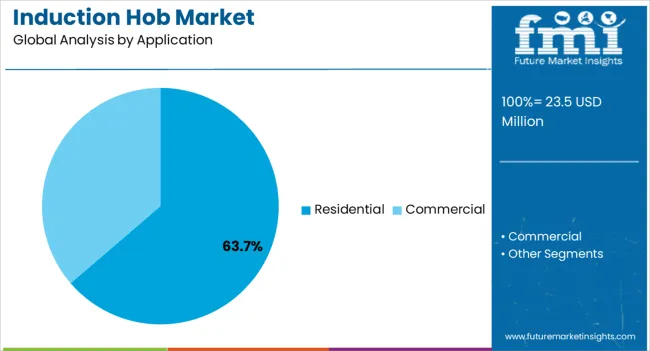
The residential segment, accounting for 63.7% of the application category, has retained leadership due to strong adoption across urban households and growing penetration in emerging economies. Consumers are increasingly opting for induction hobs over conventional gas systems due to safety, efficiency, and ease of use.
Expanding middle-class income levels and rapid urban housing developments have accelerated residential installations. The segment has also gained traction from heightened awareness of eco-friendly appliances and government initiatives promoting energy-efficient cooking technologies.
Integration with smart home ecosystems and the availability of compact, user-friendly designs are further boosting adoption Sustained demand is anticipated as lifestyle upgrades, convenience preferences, and cost savings in long-term usage continue to align with consumer purchasing decisions, ensuring residential applications remain the cornerstone of the induction hob market.
The induction hob market is tipped to have been valued at USD 14.9 million in 2020. The market is likely to have had a healthy CAGR of 8.8% for the historical period from 2020 to 2025.
There was a gradual increase in the adoption of induction hobs into kitchens. The pandemic resulted in a number of people taking to cooking at home. Thus, there was an increased demand for kitchen appliances, including induction hobs. Conversely, the commercial sector, including restaurants, bars, and cafes, faced closure, proving to be a stumbling block for the market. However, with the reopening of public spaces, the market flourished again.
For 2025, the value of the induction hob market is estimated at USD 23.5 million. During the forecast period from 2025 to 2035, the market is expected to progress at an encouraging pace, with a CAGR of 9.5%.
Growth in the number of kitchens facilitates the sale of induction hob. The number of kitchens is rising as a result of growth in the number of eateries as well as the number of homes. In both commercial spaces and residences, the induction hob is proving to be a reliable product. Thus, the progress of the kitchen appliance is forecasted to be encouraging over the forecast period.
With sustainability trends predicted to continue growing over the forecast period, eco-friendly kitchen appliances are in for good growth. Induction hobs fall under the eco-friendly kitchen appliances umbrella and thus are seeing rapid growth. In addition, the safety and the efficiency provided by the product is predicted to help the market in the forecast period. By 2035, the market is projected to have grown to USD 48.7 million.
The induction hob market can be separated into two segments: type and application. By looking at the segments, the type of induction hobs preferred by consumers becomes known. Further, the space where induction hob finds most application also becomes clear.
Built-in cooktops continue to reign as the most popular type of induction hob. For 2025, built-in cooktops are expected to account for 61.2% of the market share by type.
Built-in cooktops are the traditional type of hobs. For many consumers, built-in cooktops are the norm and there is little reason to switch. However, portable and freestanding hobs are also becoming popular, as more convenience is sought in the kitchen.
| Attributes | Details |
|---|---|
| Top Type | Built-in Cooktops |
| Market Share in 2025 | 61.2% |
Induction hobs are finding the most application in commercial spaces. In 2025, commercial application is anticipated to hold 32.7% of the market share.
Rise in the number of commercial buildings as well as hotels and eateries is leading to more kitchens being built. As businesses aim to grow efficiently, time and energy-saving solutions are sought in the kitchen too. Thus, induction hobs are finding greater application in commercial spaces.
| Attributes | Details |
|---|---|
| Top Application | Commercial |
| Market Share in 2025 | 32.7% |
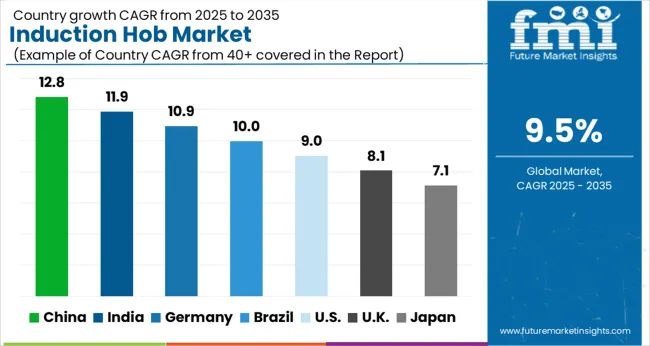
North America contributes heavily to the market, with the United States a lucrative country. However, the growth in Canada is set to outpace the growth in the United States.
In Europe, Italy and Spain are tipped to have fast growth in regards to the induction hob market. The population of India and China ensures the market has high potential in the countries. However, the technologically advanced nations of Japan and Singapore are marked for even faster growth rates than India and China in the Asia Pacific. Australia is another country with promise.
| Countries | CAGR (2025 to 2035) |
|---|---|
| Canada | 12.2% |
| Japan | 13.8% |
| Australia | 14.0% |
| Italy | 11.2% |
| Singapore | 11.9% |
Canada is marked as one of the leading countries in terms of growth for the market in North America. For the forecast period of 2025 to 2035, the CAGR for the market in Canada is estimated to be a robust 12.2%.
Canada is one of the northernmost countries in the world and thus often in the throes of bitter cold. As a result, in recent years natural gas prices have escalated rapidly in the country. Consumers in Canada are thus turning away from gas-powered kitchen appliances and preferring products like induction hobs.
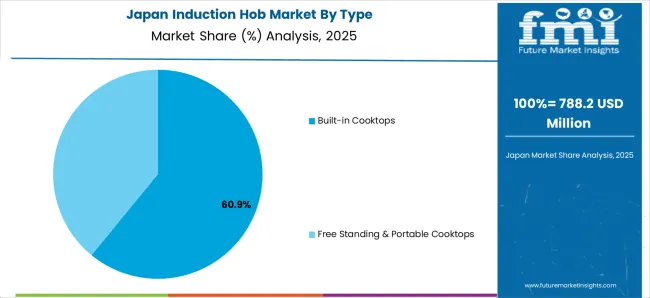
Japan is one of the leading countries in Asia for the market. For the 2025 to 2035 period, the market is forecasted to grow at a monumental 13.8% CAGR in Japan.
The expanding economy of Japan is leading to a constant increase in urbanization. As a result, not only are the disposable incomes of people growing, but so are service spaces. Thus, there is a rise in the number of people able to afford induction hobs as well as the number of commercial kitchens.
Singapore is another Asian country with high potential for the market. For the forecast period, the CAGR in Singapore is estimated to be an impressive 11.9%.
Singaporean kitchens are becoming advanced at a rapid rate. The introduction of advanced kitchen appliances is aiding the induction hob market too. For example, in September 2025, Samsung Singapore added to its Bespoke range of products by introducing the Bespoke Induction Hob. The hob has both energy-saving and aesthetic value and can also be synced with the Bespoke Wall-mount Hood for turning on and off.
Australia is penciled in to be one of the most lucrative regions for the market in the forecast period. The CAGR during the period from 2025 to 2035 for the market in Australia is predicted at an astonishing 14.0%.
One of the criticisms of induction hobs is the high cost associated. However, companies in Australia are working to rid the product of the price stigma. For example, in March 2025, Australian player Esatto launched the 60cm Induction Cooktop with Power Phase ECI604T, which was made available at an affordable price.
Italy has one of the highest growth rates for Europe in the market. For the 2025 to 2035 period, the CAGR for Italy is a remarkable 11.2%.
Italy’s great culinary tradition has led to world-famous dishes like pizza and pasta. Italy has also been influential in the number of companies that supply kitchen equipment. Among the market players in Italy are FABER, Foster, and Baraldi. Thus, the presence of several companies as well as a strong culinary culture is aiding the market in Italy.
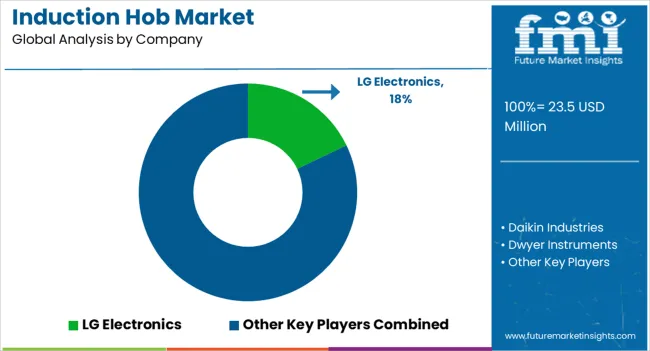
The induction hob market is fairly fragmented. The presence of industrial giants is felt but smaller companies are not shut off from the market and have opportunities to thrive.
New product launches are key for many market players. To keep the product line flowing, companies, especially the higher-end ones, invest heavily in Research and development.
Recent Developments in the Induction Hob Market
The global induction hob market is estimated to be valued at USD 23.5 million in 2025.
The market size for the induction hob market is projected to reach USD 58.2 million by 2035.
The induction hob market is expected to grow at a 9.5% CAGR between 2025 and 2035.
The key product types in induction hob market are built-in cooktops and free standing & portable cooktops.
In terms of application, residential segment to command 63.7% share in the induction hob market in 2025.






Our Research Products

The "Full Research Suite" delivers actionable market intel, deep dives on markets or technologies, so clients act faster, cut risk, and unlock growth.

The Leaderboard benchmarks and ranks top vendors, classifying them as Established Leaders, Leading Challengers, or Disruptors & Challengers.

Locates where complements amplify value and substitutes erode it, forecasting net impact by horizon

We deliver granular, decision-grade intel: market sizing, 5-year forecasts, pricing, adoption, usage, revenue, and operational KPIs—plus competitor tracking, regulation, and value chains—across 60 countries broadly.

Spot the shifts before they hit your P&L. We track inflection points, adoption curves, pricing moves, and ecosystem plays to show where demand is heading, why it is changing, and what to do next across high-growth markets and disruptive tech

Real-time reads of user behavior. We track shifting priorities, perceptions of today’s and next-gen services, and provider experience, then pace how fast tech moves from trial to adoption, blending buyer, consumer, and channel inputs with social signals (#WhySwitch, #UX).

Partner with our analyst team to build a custom report designed around your business priorities. From analysing market trends to assessing competitors or crafting bespoke datasets, we tailor insights to your needs.
Supplier Intelligence
Discovery & Profiling
Capacity & Footprint
Performance & Risk
Compliance & Governance
Commercial Readiness
Who Supplies Whom
Scorecards & Shortlists
Playbooks & Docs
Category Intelligence
Definition & Scope
Demand & Use Cases
Cost Drivers
Market Structure
Supply Chain Map
Trade & Policy
Operating Norms
Deliverables
Buyer Intelligence
Account Basics
Spend & Scope
Procurement Model
Vendor Requirements
Terms & Policies
Entry Strategy
Pain Points & Triggers
Outputs
Pricing Analysis
Benchmarks
Trends
Should-Cost
Indexation
Landed Cost
Commercial Terms
Deliverables
Brand Analysis
Positioning & Value Prop
Share & Presence
Customer Evidence
Go-to-Market
Digital & Reputation
Compliance & Trust
KPIs & Gaps
Outputs
Full Research Suite comprises of:
Market outlook & trends analysis
Interviews & case studies
Strategic recommendations
Vendor profiles & capabilities analysis
5-year forecasts
8 regions and 60+ country-level data splits
Market segment data splits
12 months of continuous data updates
DELIVERED AS:
PDF EXCEL ONLINE
Portable Induction Hobs Market Trends & Forecast 2025 to 2035
Induction Brazing Services Market Size and Share Forecast Outlook 2025 to 2035
Induction Cooktop Market Forecast and Outlook 2025 to 2035
Induction Furnace Market Size and Share Forecast Outlook 2025 to 2035
Induction Sealing Machines Market Size and Share Forecast Outlook 2025 to 2035
Induction Motors Market - Growth & Demand 2025 to 2035
Market Share Breakdown of Induction Sealing Machines Manufacturers
Heat Induction Cap Liner Market Size and Share Forecast Outlook 2025 to 2035
Analysis and Growth Projections for Powder Induction and Dispersion Systems Business
Vertical Induction Hardening System Market Size and Share Forecast Outlook 2025 to 2035
Commercial Induction Cooktops Market Growth - Trends & Forecast 2025 to 2035
High Magnetic Induction Grain-Oriented Silicon Steel Market Size and Share Forecast Outlook 2025 to 2035
Hob Market Forecast and Outlook 2025 to 2035
Competitive Landscape of Hob Market Share
Orthobiologics Market is segmented by Product Type and End User from 2025 to 2035
Psychobiotic Supplements Market Outlook - Growth, Demand & Forecast 2025 to 2035
Hydrophobic Coating Market Forecast and Outlook 2025 to 2035
Hydrophobing Agents Market Size and Share Forecast Outlook 2025 to 2035
Hydrophobic Paper Market Report – Demand, Trends & Industry Forecast 2025-2035
Hydrophobic Interaction Chromatography Resins Market

Thank you!
You will receive an email from our Business Development Manager. Please be sure to check your SPAM/JUNK folder too.
Chat With
MaRIA